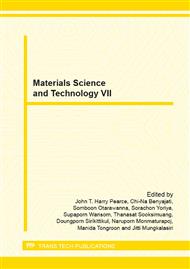p.24
p.31
p.36
p.47
p.52
p.57
p.63
p.69
p.77
Virgin Coconut Oil Containing Injectable Vehicles for Ibuprofen Sustainable Release
Abstract:
Virgin coconut oil (VCO) has been utilized as traditional medicine and herbal vehicle especially in tropical countries. The wax formation dispersed in this oil during storage at cool environment makes it not homogenous and opaque. The utilization of this oil is limited for the cool climate countries and also this is difficult for using it as injectable oil vehicle in pharmaceuticals. Therefore the decrease of wax formation temperature will possibly diminish this problematic behavior. The purpose of this study is to investigate the wax inhibitor capability of other injectable vehicles and controlled drug release characteristic of VCO without or containing these vehicles. Ibuprofen (IB) which is non steroidal anti-inflammatory drugs (NSAIDs) was used as a model drug because it can be soluble in VCO. N-methyl-2-pyrrolidone (NMP), benzyl benzoate (BB), benzyl alcohol (BA), isopropyl myristate (IM) and ethyl oleate (EO) were employed as injectable vehicles. Viscosity, pour point, cloud point and polarized light microscope examinations were conducted to characterize the change of VCO physical properties. In vitro drug release experiment was performed using dialysis method at 50 rpm and 37 °C, in phosphate buffer pH 7.4. Then least square fitting in vitro release data to the different mathematical expressions (power law, first order, Higuchi’s and zero order) was carried out using Scientist 2.1 Programme. Because injectable vehicles decreased viscosity of VCO, they improved the efficiency for measuring the VCO viscosity at lower temperature. BB and NMP were chosen as representative of the injectable vehicles because they showed many proper properties for injectable formula. Both pour point and cloud point were apparently reduced by BB greater than NMP, because BB could disturb the wax crystal formation as seen under polarized light microscope. The release rates of IB without or containing injectable vehicles were not different. From curve fitting, drug release profiles were first order kinetic therefore the drug release depended on the drug concentration in dialysis tube. From the results indicated that the injectable vehicles especially, BB and NMP could inhibit the VCO wax formation but not affected the drug release kinetic from VCO.
Info:
Periodical:
Pages:
52-56
Citation:
Online since:
March 2013
Keywords:
Price:
Сopyright:
© 2013 Trans Tech Publications Ltd. All Rights Reserved
Share:
Citation:


